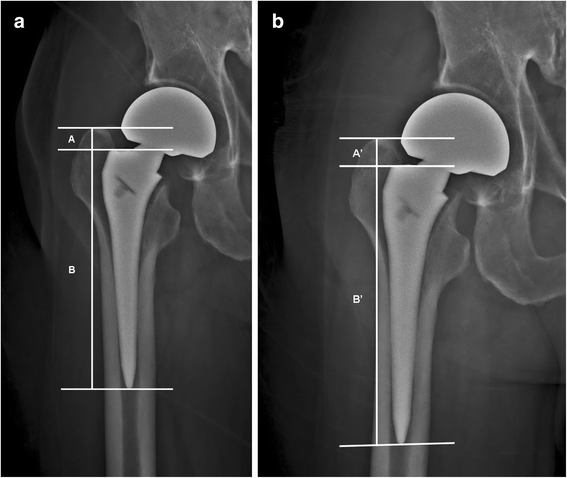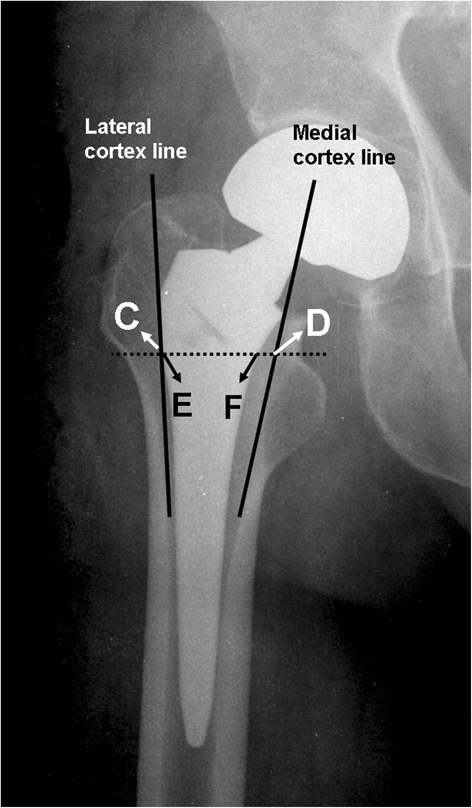Effects of teriparatide on cementless bipolar hemiarthroplasty in patients with osteoporotic femoral neck fractures
- PMID: 27435235
- PMCID: PMC4952237
- DOI: 10.1186/s12891-016-1149-x
Effects of teriparatide on cementless bipolar hemiarthroplasty in patients with osteoporotic femoral neck fractures
Abstract
Background: For osteoporotic femoral neck fractures, suitable bone-implant stability is critical for pain relief, early return to daily activities and reduction of complications. Teriparatide (parathyroid hormone [PTH1-34]) can improve bone-implant stability in some basic studies. However it's use in osteoporotic femoral neck fractures treated by cementless hemiarthroplasties for the beneficial effects on bone-implant stability is sparse in the literature. The aim of this study was to determine if post-operative teriparatide administration can reduce femoral stem migration and improve early functional recovery and health-related quality of life (HRQoL).
Methods: Between 2010 and 2014, patients with osteoporotic femoral neck fracture who underwent cementless bipolar hemiarthroplasty were included into this retrospective cohort study. Group A included patients treated with cementless bipolar hemiarthroplasty only; Group B patients had additional teriparatide. Demographic data, complications, radiographic and functional outcomes as well as health-related quality of life (HRQoL) were compared.
Results: There were 52 hips in group A (no teriparatide) and 40 hips in group B (patient who received teriparatide). The subsidence of the femoral stem tended to be significantly decreased in the teriparatide group at 6 and 12 weeks post-operatively (p = 0.003 and p = 0.008, respectively). The Harris Hip Score (HHS) increased significantly from pre-operation to 6 weeks post-operatively and thereafter up to one year in both groups. However, there were no significant differences in terms of subsequent fracture, mortality, HHS, and HRQoL between two groups during the entire study period.
Conclusions: Teriparatide significantly reduces the subsidence of the cementless femoral stem in elderly patients in the early post-operative period, but this benefit does not reflect better functional outcomes and HRQoL. Further prospective randomized large-scale cohort study is warranted for evidence-based recommendations.
Keywords: Femoral neck fracture; Hip arthroplasty; Implant migration; Osteoporosis; Teriparatide.
Figures



Similar articles
-
Outcomes of cerclage wiring to manage intra-operative femoral fracture occurring during cementless hemiarthroplasty in older patients with femoral neck fractures.Int Orthop. 2019 Nov;43(11):2637-2647. doi: 10.1007/s00264-019-04327-9. Epub 2019 Apr 9. Int Orthop. 2019. PMID: 30968166
-
Outcomes of cerclage wiring for intraoperative calcar fractures in cementless hemiarthroplasty in older patients with femoral neck fractures.Eur J Trauma Emerg Surg. 2025 Jan 24;51(1):67. doi: 10.1007/s00068-024-02736-z. Eur J Trauma Emerg Surg. 2025. PMID: 39856356
-
Cemented Bipolar Hemiarthroplasty Provides Definitive Treatment for Femoral Neck Fractures at 20 Years and Beyond.Clin Orthop Relat Res. 2015 Nov;473(11):3595-9. doi: 10.1007/s11999-015-4462-z. Epub 2015 Jul 18. Clin Orthop Relat Res. 2015. PMID: 26186915 Free PMC article.
-
The Cemented Unipolar Prosthesis for the Management of Displaced Femoral Neck Fractures in the Dependent Osteopenic Elderly.J Arthroplasty. 2016 May;31(5):1040-6. doi: 10.1016/j.arth.2015.11.029. Epub 2015 Dec 2. J Arthroplasty. 2016. PMID: 26742902 Review.
-
Cemented versus uncemented hemi-arthroplasty for femoral neck fractures in elderly patients: A systematic review and meta-analysis of randomized controlled trials.Medicine (Baltimore). 2020 Feb;99(8):e19039. doi: 10.1097/MD.0000000000019039. Medicine (Baltimore). 2020. PMID: 32080078 Free PMC article.
Cited by
-
Bone density changes after five or more years of unilateral lower extremity osseointegration: Observational cohort study.Bone Rep. 2023 Apr 28;18:101682. doi: 10.1016/j.bonr.2023.101682. eCollection 2023 Jun. Bone Rep. 2023. PMID: 37205925 Free PMC article.
-
Effectiveness of Teriparatide on Fracture Healing: A Systematic Review and Meta-Analysis.PLoS One. 2016 Dec 20;11(12):e0168691. doi: 10.1371/journal.pone.0168691. eCollection 2016. PLoS One. 2016. PMID: 27997614 Free PMC article.
-
Anabolic agents: what is beyond osteoporosis?Osteoporos Int. 2018 May;29(5):1009-1022. doi: 10.1007/s00198-018-4507-8. Epub 2018 Apr 7. Osteoporos Int. 2018. PMID: 29627891 Free PMC article. Review.
-
Can posterior stand-alone expandable cages safely restore lumbar lordosis? A minimum 5-year follow-up study.J Orthop Surg Res. 2020 Sep 29;15(1):442. doi: 10.1186/s13018-020-01866-5. J Orthop Surg Res. 2020. PMID: 32993711 Free PMC article.
-
Results of Conversion from Failed Austin-Moore Hemiarthroplasty to Cementless Total Hip Arthroplasty in Octogenarian Patients with Advanced Acetabular Erosion: A Minimum of 5 Years of Follow-Up.Biomed Res Int. 2019 Apr 2;2019:7814602. doi: 10.1155/2019/7814602. eCollection 2019. Biomed Res Int. 2019. PMID: 31061827 Free PMC article. Clinical Trial.
References
-
- Gehrig LM, Lane JM, O’Connor MI. Osteoporosis: management and treatment strategies for orthopaedic surgeons. Instr Course Lect. 2009;58:817–832. - PubMed
-
- Schmidt AH, Braman JP, Duwelius PJ, et al. Geriatric trauma: the role of immediate arthroplasty. J Bone Joint Surg Am. 2013;95:2230–2239. - PubMed
-
- Stephen R, Burnett J. Total hip arthroplasty: techniques and results. BCMJ. 2010;52:455–464.
MeSH terms
Substances
LinkOut - more resources
Full Text Sources
Other Literature Sources
Medical

